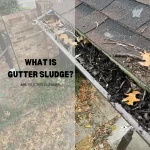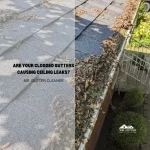Using a pressure washer to clean gutters is a topic that homeowners often explore, especially when seeking efficient home maintenance solutions. The central question is whether this method is safe for both the gutters and the user.
Pressure washers, known for their powerful cleaning capabilities, can significantly reduce the time and effort involved in gutter cleaning.
However, their high-pressure water stream poses potential risks to gutter integrity and requires careful handling to prevent damage.
The safety and effectiveness of using a pressure washer depend on various factors such as the equipment’s settings, the user’s technique, and the condition of the gutters.
This discussion is particularly relevant for homeowners aiming to maintain their property while avoiding water damage, pest intrusion, and preserving curb appeal.
Understanding the nuances of using a pressure washer for gutter cleaning involves considering its impact on the gutters’ material, the risk of water intrusion into sensitive areas of the home, and personal safety precautions.
This exploration will delve into these aspects, offering insights for homeowners to make informed decisions about this cleaning method.
Understanding Pressure Washing Technology
Pressure washing technology harnesses high-pressure water to effectively clean various surfaces. This technology is particularly relevant in home maintenance, especially for tasks like gutter cleaning. Understanding how pressure washers work and their appropriate applications is crucial for safe and effective use.
Basics of Pressure Washer Operation
Pressure washers operate by propelling water at high speeds, creating a forceful water stream. This process involves a motor that powers a pump, pressurizing water from a source and directing it through a hose to a nozzle. The user can control the pressure and the spray pattern, which is essential for various cleaning tasks. The effectiveness of a pressure washer largely depends on its pressure setting and nozzle type, making it versatile for different home maintenance tasks, including gutter cleaning.
Table of Contents:
- Understanding Pressure Washing Technology
- Assessing Gutter Material and Condition
- Risks Involved in Pressure Washing Gutters
- Best Practices for Safe Pressure Washing
- Protective Gear and Safety Measures
- Alternatives to Pressure Washing Gutters
- Long term Maintenance of Gutters Post Cleaning
- Legal and Environmental Considerations
Types of Pressure Washers and Their Uses
There are two primary types of pressure washers: electric and gas-powered. Electric models are generally lighter, quieter, and suitable for light to moderate tasks like cleaning cars, patios, and small areas. Gas-powered washers offer more power and mobility, making them ideal for heavy-duty tasks like cleaning large driveways, siding, and gutters. Selecting the right type depends on the task’s nature and intensity.
Assessing Gutter Material and Condition
The material and condition of gutters play a pivotal role in determining the suitability of using a pressure washer for cleaning. Gutters vary in materials and durability, and the right approach to cleaning them can prevent damage and extend their lifespan.
Identifying Different Gutter Materials
Gutters are commonly made from materials like aluminum, steel, vinyl, or copper. Each material has distinct characteristics and tolerance levels to pressure. For instance, aluminum gutters are lightweight and prone to denting under high pressure, whereas steel gutters are more robust. Knowing the gutter material is crucial to applying the correct pressure during cleaning.
Evaluating the Current State of Your Gutters
Before using a pressure washer, inspect the gutters for any signs of damage, wear, or weak points. Existing damage, such as cracks or loose sections, might be exacerbated by high-pressure water. Additionally, assessing the level of debris accumulation can guide the pressure and nozzle choice for effective cleaning without causing harm to the gutter system.
Risks Involved in Pressure Washing Gutters
The process of cleaning gutters with a pressure washer involves inherent risks that need careful consideration. These risks stem from both the powerful nature of pressure washers and the specific characteristics of gutter systems. Understanding these risks is crucial for homeowners to make informed decisions and take necessary precautions.
Potential for Gutter Damage
One of the primary risks is damage to the gutters themselves. High-pressure water streams can be too forceful for gutters, especially if they are made from materials like aluminum or vinyl. This can result in warping, denting, or even detaching gutters from the roof. The risk is higher for aged or already weakened gutter systems. Careful assessment of gutter material and condition is essential before proceeding with pressure washing.
Safety Concerns for Homeowners
Another significant concern is the safety of the homeowner or the person performing the cleaning. Handling a pressure washer, especially on a ladder or at a height, increases the risk of falls and injuries. The force of the water stream can lead to loss of balance, and there is also the potential for accidental injury from the high-pressure stream. Adequate safety measures, including proper use of ladders and protective gear, are critical.
Best Practices for Safe Pressure Washing
Adopting best practices for pressure washing is key to minimizing risks while ensuring effective gutter cleaning. These practices encompass choosing the right equipment settings and employing techniques that are both safe and efficient.
Selecting the Right Pressure Setting
The choice of pressure setting is vital to balance cleaning efficiency with the safety of gutter materials. Using a lower pressure setting can prevent damage to gutters and is often sufficient to remove debris and buildup. The type of nozzle used also plays a role in how the water is delivered and its impact on the gutters.
Effective Techniques for Gutter Cleaning
Effective gutter cleaning with a pressure washer involves more than just the right equipment; it also requires the right technique. This includes maintaining a safe distance between the nozzle and the gutters, using the washer at an angle that minimizes the risk of water getting under roof shingles, and avoiding directing the stream at weak points or seams in the gutter system. Additionally, ensuring personal safety through stable ladder use and protective gear is paramount.
Protective Gear and Safety Measures
When utilizing a pressure washer for gutter cleaning, it is imperative to prioritize safety. Proper protective gear and safety measures are not just recommendations, they are necessities. This ensures that the cleaning process does not lead to accidents or injuries.
Essential Personal Protective Equipment
When using a pressure washer for gutter cleaning, wearing the right protective gear is vital for safety. Essential equipment includes safety goggles to protect eyes from debris, durable gloves to safeguard hands from high-pressure water, and non-slip boots for stability, especially when working on a ladder. Additionally, wearing a helmet can protect against head injuries from any falling debris or in case of a fall.
Precautions to Prevent Accidents
Preventing accidents while pressure washing involves more than just personal protective gear. Ensuring ladder stability is crucial, use a ladder stabilizer or have a spotter for added safety. Keep the pressure washer’s hose and electrical cords properly organized to avoid tripping hazards. Be mindful of the pressure washer’s recoil when starting it to maintain balance and control.
Alternatives to Pressure Washing Gutters
For those concerned about the risks associated with pressure washing, there are safer alternatives for gutter cleaning.
Manual Gutter Cleaning Methods
For those who prefer not to use a pressure washer, manual gutter cleaning is a safe alternative. This method involves using a ladder to reach the gutters, gloves to remove debris by hand, and a bucket to collect it. Gutter scoops can help remove compacted debris, and a garden hose can rinse away the remaining dirt.
Professional Gutter Cleaning Services
Hiring professional gutter cleaning services is an effective alternative for homeowners who are not comfortable with DIY methods. Professionals have the necessary equipment and expertise to clean gutters safely and efficiently. They can also inspect for any potential gutter repairs and provide maintenance advice.
Long term Maintenance of Gutters Post Cleaning
After cleaning, maintaining gutters is key to ensuring their longevity and functionality.
Regular Gutter Inspection and Maintenance Tips
Regular inspection and maintenance are key to extending the life of gutters. Homeowners should inspect their gutters at least twice a year for any signs of blockage, damage, or wear. Clearing debris after major storms and ensuring downspouts are unobstructed are also important practices. Applying rust-resistant coatings can further protect metal gutters.
When to Seek Professional Help for Gutter Maintenance
Professional help should be sought when homeowners notice complex issues during inspections, such as significant rust, large dents, or detachment from the roof. Professionals can provide thorough inspections, undertake necessary repairs, or advise on gutter replacement if needed.
Legal and Environmental Considerations
Understanding the legal and environmental aspects is crucial in the context of pressure washing activities.
Understanding Local Regulations on Pressure Washing
Before undertaking pressure washing, homeowners should be aware of local regulations. Some areas may have restrictions on water usage or specific guidelines on how to dispose of wastewater, especially if it contains pollutants. Adhering to these regulations helps avoid legal issues and fines.
Eco-friendly Practices in Gutter Cleaning
Eco-friendly gutter cleaning practices include using biodegradable cleaning solutions and minimizing water wastage. Collecting and reusing water runoff can also reduce environmental impact. When hiring professional services, homeowners can opt for companies that use environmentally friendly methods and products.


